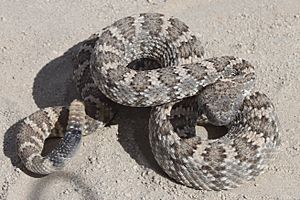Crotalus stephensi facts for kids
Quick facts for kids Crotalus stephensi |
|
|---|---|
 |
|
| Scientific classification | |
| Genus: |
Crotalus
|
| Species: |
stephensi
|
| Synonyms | |
|
|
The Panamint Rattlesnake (scientific name: Crotalus stephensi) is a type of venomous snake. It's a pitviper, which means it has special heat-sensing pits on its face. You can find this snake in parts of central and southern Nevada and nearby California. People sometimes call it the Panamint rattler or Owens Valley rattler. Just be careful not to confuse it with the tiger rattlesnake, which is a different species!
Contents
Where Does the Name Come From?
The scientific name, stephensi, was given to honor a person named Frank Stephens. He lived from 1849 to 1937. Frank Stephens was a curator (someone who manages collections) at the San Diego Society of Natural History.
What Does It Look Like?
Adult Panamint Rattlesnakes are usually about 60 to 91 centimeters (2 to 3 feet) long. The longest ones can grow up to 132 centimeters (about 4.3 feet).
This snake has some unique features on its head. It doesn't have a light line on the back edge of its nose scales. Also, the scales above its eyes can look a bit bumpy or broken on the edges.
The snake's body color can be straw yellow, tan, brown, or gray. It has a pattern of blotches (spots) that are buff, gray, brown, or deep reddish-brown. Sometimes, you might see gray patches on the sides of its body and head. It can also have scattered black-tipped scales on its back, especially around the edges of its blotches.
Where Does It Live?
The Panamint Rattlesnake lives in desert-mountain areas. You can find it on the eastern slopes of the Sierra Nevada mountains. This includes places from Mono County, California, to Nye County, Nevada. It also lives in southwestern Nevada, southeastern Clark County, Nevada, and central San Bernardino County, California. These snakes live at altitudes from about 900 to 2,400 meters (about 3,000 to 8,000 feet) high.
What Does It Eat?
The Panamint Rattlesnake likes to eat small mammals, lizards, and birds.
How Does It Have Babies?
Crotalus stephensi is ovoviviparous. This means the mother snake keeps the eggs inside her body until they hatch. The young snakes are then born live. Babies are usually born in July and August. When they are born, they are about 25 centimeters (10 inches) long.

